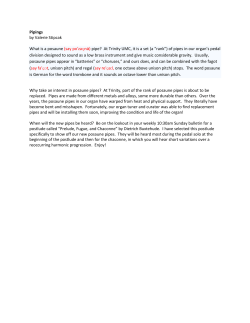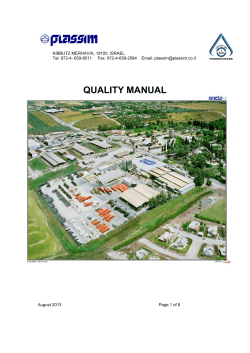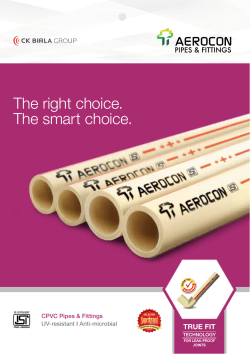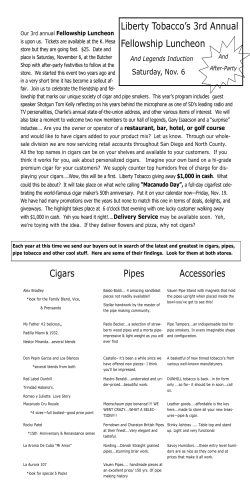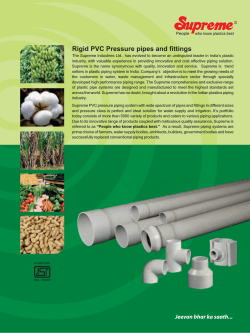
Catalogue KG 2000 Polypropylen
62 KG 2000 SN 10 Polypropylene Waste water pipes KG 2000 SN 10 Polypropylene Waste water pipes ISO 9001 Waste water pipes KG 2000 SN 10 Polypropylene KG 2000 SN 10 Polypropylene These days the world is future-oriented and facing modernization. Driven by the speed of today´s world the modern man interferes more and more in the nature. As a consequence of our endeavour to pollute the environment as little as possible, the modern KG 2000 SN 10 Polypropylene waste water system has been developed to meet highest demands. 63 Benefits and Advantages of the System Material Properties Waste water pipes KG 2000 SN 10 Polypropylene Material Polypropylene (PP), mineral-reinforced • m odern highly-developed pipe with massive wall technology Pipe construction • extensive full range DN 110 – 500 Massive wall pipe system with homogenous wall construction. • stability under extreme conditions • improved patented gasket Connection Push-fit connection with a patented factory-inlaid gasket. • high impact resistance • high abrasion resistance Seal Gaskets according to DIN EN 681. • smooth inside surface • easy-to-install Colour Spring green RAL 6017. • long lasting • SLW 60 from 0.8 m Quality requirements DIN EN 14758. • ring stiffness SN 10 Production • WITH NBR GASKETS USE AS grease pipe with trace heating Plastics piping systems for non-pressure underground drainage and sewerage – Polypropylene with mineral modifiers (PP-MD). The general requirements for components used in discharge pipes, drains and sewers for gravity systems according to DIN EN 476 as well as the general quality requirements of DIN 8078 are the basis for the production of the pipes and fittings. • w ith NBR gaskets suitable for draining petrol station waste water AREA OF APPLICATION Underground sewers and waste water pipes. The pipes are resistant to normal waste water (pH 2 – pH 12) - see chapter Chemical resistance page 124ff. www.ostendorf-kunststoffe.com 65 KG 2000 SN 10 Polypropylene 66 Waste water pipes KG 2000 SN 10 Polypropylene Waste water pipes for highest demands Description Polypropylene waste water pipes and fittings resistant to hot water and light effects, produced in accordance with DIN EN 14758-1. DN(OD) s [mm] D [mm] 110 3,4 128,4 72 125 3,9 146,0 80 160 4,9 186,6 95 200 6,2 236,0 123 133 250 7,7 287,2 315 9,7 358,8 155 400 12,3 455,0 180 500 15,3 565,0 205 PP – The material of the future Temperature – ranges of application Polypropylene (PP), polypropylene is a thermoplastic material belonging to the group of polyolefin's. These plastics have already been used with great success in pipe production for several decades. Polypropylene is also used in the automobile industry and in fuel stations since it meets high safety requirements. Guaranteed safety from a hygienic point of view, resistance to corrosion, good processing properties and several additional factors ensure a wide range of applications. Worldwide consumpion of plastic materials Source : Solvay 1997, ChemSystems •High chemical resistance pH2 – pH 12 (acid/alkaline) – resistant to bioorganic sulphuric acid corrosion » see chapter Chemical resistance page 124ff •High abrasion resistance of PP – long lasting and safe in operation abrieb (mm) Abrasion (mm) tons (m) t [mm] Steinzeug Stoneware Pvc-u 1 PP 0 0 2 x 10 5 lastspiele 4 x 10 5 Variation in stress PP - Properties With respect to DIN EN 476, polypropylene has excellent thermal properties. It can also be used under extreme conditions. •Excellent impact resistance and extremely tough – does not tend to crack or spread cracks – robust under mechanical stress (e. g. high-pressure flushing) www.ostendorf-kunststoffe.com Waste water pipes • KG 2000 SN 10 Polypropylene Leakage test according to DIN EN 1610 with air and water from 0.05 bar to 0.5 bar and vacuum. (System test 3.0 bar MPA Darmstadt). Smooth inside surface – optimal hydraulics – no incrustation – deposits do not get caught – self-cleaning, requires less maintenance PP - Properties An important requirement in private and public waste water systems is a long lasting water-tight pipe connection against leakage of waste water and ground water. The new innovative and patented gasket is a result of a long development. The decisive improvements are achieved by the special design. ➊ The new sealing system ➊Tensioning lip ➋Retaining lip ➌ Wiping lip ➍ Sealing lip ➋ ➌ Insertion forces The insertion forces are considerably reduced by the special gasket design. This makes installation far easier compared to the usual sewer pipe systems. ➍ Ecological value to the environment • material Polypropylene PP • ground water neutral • durable leak-proof pipe connection The function of each gasket element ➊Tensioning lip The tensioning lip prevents dirt build-up between the pipe wall and the gasket. ➋Retaining lip The retaining lip causes the tensioning lip to be pressed against the foremost edge of the gasket groove. This stops the gasket ring from being pressed out or rolling. ➌ Wiping lip The wiping lip serves to keep back any dirt on the pipe. ➍ Sealing lip The sealing lip assures a tight long-term pipe connection. Polypropylene, an environmentally-friendly material due to the method of production, recyclability and the resistance to aggressive media. The new KG 2000 SN 10 sealing system provides enhanced protection against infiltration and exfiltration of waste water into the ground water. Polypropylene – ecologically valuable, the material of the future. www.ostendorf-kunststoffe.com 67 Product Range KG 2000 SN 10 Polypropylene Waste water pipes KG 2000 SN 10 Polypropylene KG 2000 – Pipe SN 10 No. DN L [mm] Unit 770320 110 500 1/80 770340 110 1000 1/80 770360 110 2000 1/80 770380 110 5000 1/80 770420 125 500 1/60 770440 125 1000 1/54 770460 125 2000 1/54 770480 125 5000 1/54 770520 160 500 1/35 770540 160 1000 1/35 770560 160 2000 1/35 770580 160 5000 1/35 770620 200 500 1/20 770640 200 1000 1/25 770660 200 2000 1/25 770680 200 5000 1/25 770740 250 1000 1/16 770770 250 3000 1/16 1/16 770790 250 6000 770840 315 1000 1/9 770870 315 3000 1/9 770890 315 6000 1/9 770940 400 1000 1/4 770970 400 3000 1/4 770990 400 6000 1/4 771040 500 1000 1/4 771070 500 3000 1/4 771090 500 6000 1/4 www.ostendorf-kunststoffe.com L KG2000EM – Single socket pipe (push-fit) 69 70 KG 2000 SN 10 Polypropylene Waste water pipes KG2000B – Bend 15˚ KG 2000 – Fitting SN 10 No. DN α z1 z2 l1 Unit 771300 110 15° 9 16 87 4/260 771400 125 15° 10 19 93 4/160 771500 160 15° 24 19 120 4/84 771600 200 15° 15 31 158 1/40 771700 250 15° 23 44 163 1/24 771800 315 15° 28 56 188 1/12 771900 400 15° 29 67 220 1/6 771100 500 15° - - - 1/2 KG2000B – Bend 30˚ No. DN α z1 z2 l1 Unit 771310 110 30° 17 23 95 4/240 771410 125 30° 19 27,5 102 4/160 771510 160 30° 24 34 125 4/84 771610 200 30° 29 46 162 1/40 771110 500 30° - - - 1/2 KG2000B – Bend 45˚ No. DN α z1 z2 l1 Unit 771320 110 45° 26 29 94 4/200 771420 125 45° 29 36 112 4/144 771520 160 45° 37 45 144 4/60 771620 200 45° 46 57 189 1/38 771720 250 45° 59 77 199 1/20 771820 315 45° 73 98 233 1/10 771920 400 45° 92 120 283 1/5 771120 500 45° - - - 1/2 KG2000B – Bend 67˚ No. DN α z1 z2 l1 Unit 771330 110 67° 41 47 119 4/180 771430 125 67° 44 54 127 4/120 771530 160 67° 56 69 161 2/60 KG2000B – Bend 87˚ No. DN α z1 z2 l1 Unit 771350 110 87° 59 65 137 4/160 771450 125 87° 66 72 145 4/108 771550 160 87° 84 91 180 2/60 KG2000EA – Branch 45 ° No. DN α z1 z2 z3 L [mm] Unit 772330 110/110 45° 26 134 134 228 4/96 772340 125/110 45° 81 91 91 240 2/76 772440 125/125 45° 29 152 152 255 2/64 772350 160/110 45° 2 168 162 250 2/46 772450 160/125 45° 10 179 175 260 2/40 772550 160/160 45° 37 195 195 320 2/28 772560 200/160 45° 19 221 218 - 1/20 772660 200/200 45° 46 244 244 - 1/15 772760 250/160 45° 57 258 311 - 1/10 1/8 772770 250/250 45° 57 311 311 - 772850 315/160 45° 40 301 250 - 1/7 772860 315/200 45° 72 325 393 - 1/5 772880 315/315 45° 72 393 393 - 1/4 772940 400/160 45° 82 394 526 - 1/3 772960 400/200 45° 55 417 555 - 1/2 772990 400/400 45° 78 683 683 - 1/1 771130 500/160 45° - - - - 1/2 www.ostendorf-kunststoffe.com KG 2000 SN 10 Polypropylene Waste water pipes 71 No. DN α z1 z2 z3 L [mm] Unit 774330 110/110 87° 59 64 64 197 4/120 774350 160/110 87° 15 141 140 227 2/46 774550 160/160 87° 81 91 91 279 2/32 L KG2000EA – Branch 87 ° KG2000U – Coupler No. DN l [mm] Unit 778300 110 136 4/280 778400 125 151,4 4/200 4/96 778500 160 185 778600 200 239 1/54 778700 250 275 1/30 778800 315 299 1/12 778900 400 345 1/8 771160 500 - 1/4 KG2000MM – Double socket No. DN l [mm] Unit 777300 110 136 4/280 777400 125 151,4 4/200 777500 160 185 4/96 777600 200 239 1/54 777700 250 275 1/30 777800 315 299 1/12 777900 400 345 1/8 771170 500 - 1/4 DN l [mm] Unit KG2000M – Plug No. 777320 110 55 4/780 777420 125 55 4/580 777520 160 70 4/260 777620 200 85 2/160 777720 250 88 1/100 777820 315 98 1/50 777920 400 116 1/32 771180 500 - 1/12 No. DN z1 L [mm] Unit 775340 125/110 16 99 4/240 775350 160/110 34 135 4/192 775450 160/125 28 129 4/104 2/60 775560 200/160 32 175 775670 250/200 49 181 1/40 775780 315/250 63 215 1/25 775880 400/315 91 271 1/10 771190 500/400 - - 1/4 KG2000RE – Inspection pipe No. DN L [mm] Unit 778310 110 308 2/80 2/70 778410 125 313 778510 160 380 1/40 778610 200 410 1/20 www.ostendorf-kunststoffe.com L KG2000R – Reducer – eccentric KG 2000 SN 10 Polypropylene Waste water pipes KG2000UG – Connection piece to cast-iron pipe No. DN d6 l [mm] Unit 778320 110 124 133 4/420 778420 125 151 151 1/360 778520 160 176 165 1/210 KG2000US – Connection piece to stoneware pipe – spigot end No. DN d [mm] l [mm] Unit 777380 110 138 168 4/288 777480 125 163 172 1/180 777580 160 194 226 4/96 KG2000USM – Connection piece to stoneware pipe - socket l 72 No. DN D [mm] l [mm] Unit 777390 110 132 90 4/380 777490 125 160 92 1/320 777590 160 187 97 4/168 KG 2000 – Accessories KG2000 – Lip seal No. DN Unit 880400 110 20 880410 125 18 880420 160 21 880430 200 10 880440 250 - 880450 315 - 880460 400 - 880470 500 - KG2000 – NBR gasket (oil resistant) No. DN Unit 880500 110 20 880510 125 27 880520 160 10 880530 200 10 880540 250 - 880550 315 - 880560 400 - 880570 500 - No. DN Unit 881025 110 16 NEW! KG2000 – GA-Gasket www.ostendorf-kunststoffe.com KG 2000 SN 10 Polypropylene Waste water pipes KG 2000 – Accessories KG2000 – GA-Set gasket No. DN Unit 881030 125 10 881040 160 15 KG2000 – Profile gasket for KGUS No. DN Unit 881100 110 144 881110 125 90 881120 160 50 KGF PU – Chamber lining No. DN α d [mm] l [mm] Unit 820900 110 3° 110,4 110 1/325 821900 125 3° 125,4 110 1/270 822900 160 3° 160,5 110 1/180 823900 200 3° 200,6 110 1/114 820910 110 3° 110,4 240 1/168 821910 125 3° 125,4 240 1/135 822910 160 3° 160,5 240 1/84 823910 200 3° 200,6 240 1/45 824910 250 3° 250,8 240 1/33 825910 315 3° 316,0 240 1/18 826910 400 3° 401,2 240 1/15 827910 500 3° 501,5 240 1/12 KG2000BA – Connection to concrete pipe No. DN l [mm] Unit 877570 150 165 1/90 877670 200 197 1/40 KG2000 – Lubricant No. ml Unit 881800 150 50/1750 50/1500 881810 250 881820 500 24/720 881830 1000 12/360 www.ostendorf-kunststoffe.com 73 74 KG 2000 Polypropylene Waste water pipes Installation Instructions www.ostendorf-kunststoffe.com Waste water pipes 1. KG 2000 SN 10 Polypropylene Scope The following instructions apply for utilization and installation of KG2000 SN 10 pipes and fittings made of polypropylene (PP), colour spring green RAL 6017, which serve as nonpressure underground pipes for the drainage of waste water according to DIN 1986-3. Should the soil in question not be suitable as a support, the ditch bed must be dug deeper and a support made. The thickness of the lower embedding layer may not exceed the following: a)100 mm in the case of normal soil b)150 mm in the case of stones or compact soil For the production of waste water piping systems, the recommendations under DIN 1986-1, DIN 1986-4 and DIN EN 1610 apply. 3 4 10 5 6 13 7 OD 8 KG 2000 SN 10 pipes and fittings can be used as: a)Ground pipes b)Connection sewers 9 as well as in heavy duty areas (SLW 60) with a minimum covering of 0.8m, with a maximum covering of 6 m and in ground water regions. 3. Transporting and storing KG 2000 SN 10 pipes and fittings The pipes and fittings are to be protected against damage. The pipes should be supported over their entire length during transport in order to avoid sagging. Impact stress – especially under freezing temperatures – must be avoided. Pipes and fittings may be stored outdoors. The following measures must be observed on storing pipes: a)Pipes must be stored in such a manner that perfect support is ensured and no deformations can occur. b)The pipe layers can be stored both with and without wood in between them. c)On storing, the pipe sockets should be horizontally and vertically unhampered. d)A stacking height of 2 meters should not be exceeded. Rubber sealing elements, if not protected, should not be stored outside for long periods. 4. 2 c Area of application KG 2000 SN 10 polypropylene waste water pipes and fittings are suitable for the use as underground pipes, sewer connections and sewer pipes for the drainage of waste water in accordance with DIN 1986-3. In special cases the chemical resistance can be seen in the DIN 8078 supplementary sheet no. 1. 1 Support and embedding Pipes can be laid in consistent, relatively loose, fine-grained soil if a support along the entire length is possible. At the sockets, hollows are to be made in the lower embedding area so that the connection can be properly carried out. The hollows may not be larger than necessary in order to carry out proper connections. a b 2. 75 1 Surface 2Lower edge of the road or rail structure, if present 3 Ditch walls 4 Main filling (3.6) 5 Cover (3.5) 6 Side filling (3.12) 7 Upper bedding layer 8 Lower bedding layer 9 Ditch bed 12 11 0Cover height 1 11 Thickness of embedding 12Thickness of the piping area 13Ditch depth aThickness of the lower bedding layer bThickness of the upper bedding layer c Thickness of the cover The thickness of the upper embedding layer should be carried out in such a manner that structural analysis conditions are fulfilled and a support angle of 180° is achieved, i.e. generally 0.5 x DA. Should the bed of the ditch prove to not have sufficient supporting properties, special measures are required. Should, due to the construction, a concrete slab be necessary in the area on which the pipes rest, it is recommended that provision is made for an intermediate layer of suitable soil between the pipe and slab. This layer should be 150 mm under the pipe shaft and 100 mm under the connection. Should, for structural reasons, additional steps for instalment be considered essential, a concrete slab above the covering area is recommended instead of a concrete jacket for load distribution purposes. Should a concrete jacket be planned, it is to be produced in such a manner that the entire structural load can be absorbed by the jacket. 5. Embedding in concrete Polypropylene pipes and fittings may be directly embedded in concrete. However, the following instructions must be observed: www.ostendorf-kunststoffe.com KG 2000 SN 10 Polypropylene 76 a)Cover the socket gap with adhesive tape so that no concrete grout can seep in, which may then hinder the subsequent functioning of the push-fit socket. b)Protect the pipes against uplifting. The intervals between the mounting points must ensure that no excessive sagging can occur (formation of water traps). c)Thermal changes in length, both on installation and in subsequent operation, must be taken into consideration. 6. Installation procedure Prior to installation, KG 2000 SN 10 pipes and fittings must be checked for any damage. Each pipe and fitting is to be levelled according to gradient and direction. A straight, continuous path in the stipulated gradient is to be observed. In special instances, the DN 110 to DIN 315 pipe routing can be installed as indicated in the following diagram. However, the data indicated in the following table may not be exceeded. Fig. 3a Bevelling Fittings may not be shortened as otherwise their seal tightness property suffers. DN 110 125 160 200 250 315 b mm ca. 6 6 7 9 9 12 The cutting edges must be trimmed. The pipe ends must be bevelled at an angle of approx. 15°, as in the illustration, using either a suitable tool for bevelling or a coarse file. 8. (Bending of pipes > DN 200 is practically impossible in view of their greater intrinsic rigidity) Gauges h max. or bending radii in meters at a length L : h 7. DN 110 125 160 200 8 0,24 0,21 0,17 0,13 12 0,54 0,48 0,38 0,30 16 0,97 0,85 0,67 0,53 R [m] 33 38 47 61 Cutting to length and bevelling If necessary, pipes may be cut to length with a suitable plastic cutter or fine-toothed saw. Cuts are to be made at right angles to the pipe axis. A guiding frame may be useful. Fig. 3 Cutting to length with a frame Waste water pipes Setting up the connection at pipes and fittings a)Remove any dirt from the inserting end (spigot end) and sockets and, if necessary, from the sealing element. b)Check the position of the sealing elements and make sure they are in perfect condition. c)Coat the bevelling of the inserting end evenly with a lubricant. Do not use any oil or grease! d)Push the inserting end into the socket until it resists and make a marking on the edge of the socket with a pencil or a felt-tip pen. Finally the pipe end must be pulled approx. 3 mm per metre of installed total length. It must, however, be pulled out at least 10 mm. The installation of couplers and double sockets is carried out in the same manner. 9. Connection to constructions Connections to constructions (chambers etc.) are to be carried out with joints using chamber inner linings (KGF). Sealing between the chamber inner lining and the sewer pipe is carried out by means of the rubber sealing ring. 10. Filling and sealing Either earth at the location or material delivered can be used as material for the piping area as long as neither the pipe material nor the ground water are affected. A suitable bedding material is layered, grainy loose soil with a maximum granule size of < 22 mm or alternately crushed construction materials with a maximum granule size of 11 mm. Hydraulically combined construction materials such as stabilised soil, light concrete, lean-mixed concrete, non-reinforced concrete are suitable. During the procedure of filling and sealing in the region of pipes up to 30 cm above the pipe shaft, particular care must be taken that a)Pipes are not brought out of alignment or position. Sand cones or other accessories may be of assistance. b)By means of layering suitable soil and intensive compressing up to and above the recommended height, it is ensured that no hollows form under the pipes and the supporting angle stipulated in the structural analysis is achieved. www.ostendorf-kunststoffe.com Waste water pipes KG 2000 SN 10 Polypropylene Compression and the material fed in contribute directly to stability. Each layer is to be compressed either manually or with the help of light machines. Finally the remaining main filling is to be carried out in accordance with planning and instructions, in order to avoid surface subsidence. 11. Watertight test Checking to see that piping, shafts and inspection openings are watertight is either to be carried out with air (procedure "L") or with water (procedure "W"). In the case of procedure "L" the number of corrective measures and repeated checks in the case of failure is unlimited. In the case of a single or repeated failure to pass the test with air, moving on to testing with water is permissible. The result of the test with water is then decisive. All openings of the section of piping to be checked as well as branches and junctions are to be closed in a watertight manner and secured against pressure and being pressed out. It is recommended – particularly in the region of the property – that the large number of fittings be anchored by means of driving in posts or by means of anchoring them with appropriate locking clamps so that any changes in position are avoided. In straight pipelines, too, pipes and inspection stoppers are to be supported accordingly against horizontal pressure. The piping, should it not have been covered, is to be secured against changes in position. The piping is to be filled with water in such a manner that it is free of air. Therefore it makes sense to fill the pipes slowly from the lowest point so that the air present in the pipes can escape from the sufficiently-large air release points at the highest point of the piping. Air Air release point open during filing Testing with air General: The alternative air pressure test, due to its many advantages over the water pressure test, is the more popular procedure. Testing with air (testing procedure “L”) : Recommendations for testing time for piping (without shafts and inspection openings) can be seen on the following table, taking into consideration the respective pipe diameters. The procedure should be stipulated by the client. For reasons of safety, careful handling and testing are emphasised. Attention must be paid to tight fittings of the shutoff elements ! Test procedure P0*) (mbar) ∆p (kPa) DN 110 DN 125 LC 300 (5) 50 (30) 3 3 3 0,06 0,06 0,06 DN 200 DN 250 DN 315 Kp-value Testing with water 77 Test procedure P0*) (mbar) ∆p (kPa) LC 300 (5) 50 (30) Kp-value 3 3,5 4 0,06 0,06 0,06 *) Pressure above atmospheric pressure Open tank with scale Standpipe Hydrant Sufficient time (one hour) is to be provided between filling and checking the piping in order to allow any air flowing into the pipes on filling and remaining there to gradually escape. The test pressure is to be taken at the lowest point in the part to be checked. Non-pressure pipes are to be checked with 0.5 bar excess pressure. The test pressure, which must have been achieved prior to testing, has to be maintained for 30 minutes in accordance with DIN EN 1610. If necessary, the quantity of water required is to be constantly filled and gauged. The test requirements have been fulfilled when the volume of water added in 30 minutes is not more than 0.15 l/m2 for pipes. Please note : m2 describes the moistened inner surface. www.ostendorf-kunststoffe.com DN 150
© Copyright 2025
